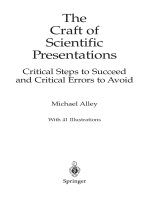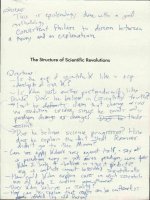The Craft of Scientific Presentations - M Alley (Springer 2003) Episode 13 pdf
Bạn đang xem bản rút gọn của tài liệu. Xem và tải ngay bản đầy đủ của tài liệu tại đây (64.83 KB, 5 trang )
Subject Index 237
Subject Index
Audience (continued):
targeting of, 28, 29–37, 206
technical, 31–37
nontechnical, viii, 31–37
Authority (see Credibility of speaker)
Background information, 6, 33, 36–37,
73–74
Backgrounds for slides, viii, 137–139
Balance, between what is spoken and
what is shown, 129–132
Beginnings of presentations, 50, 56–57,
66–75, 88–90
Bias of audience, 39–40, 52, 67, 75–78
Blackboards (see Writing boards)
Boldface on slides, 119
Building of objects or text on slides, 99–
100, 101, 135–136
Bullets, 96, 98, 139, 144, 151, 205, 215–
217
Business meeting, 47
Caltech, 10, 90
Capital letters, 121–122
Challenger, 28–31, 38, 77, 109–110, 129–
130, 147
Changing a presentation in midstream,
6, 48, 50
Character of speaker in arguments, 26–
27
Checklist for presentations, 209
Chronological strategy, 56–57
Classification strategy, 56, 59
Cold Spring Harbor, 34–35
Collaboration, 45, 61, 174
Color on slides, 5, 114, 116, 122–125,
137–139
Colorblindness, 124
Composure, 194–204
Abbreviations, 31
Acknowledgment of sponsors, 70
Actors, 49
ad lib. speaking, 45, 47, 52–53
Advantages of presentations, 3–6, 8
Airbrushed background, 137–139
All capital letters, 121–122
Analogies, 14–15, 25
Answering questions (see Questions)
Apollo 13, 38
Argumentation, 21–27, 38–40
Arrival to presentation, 159–161, 180
Atlas-3, 104
Animation of slides, 99–100, 101, 135–
136
Appeals by speaker:
to character, 26–27
to emotion, 25–26
to logic, 22–25
Assessment (see Critiquing)
Attire, 162, 181
Audience:
antagonistic, 45, 201
anticipating bias of, 39–40, 52, 67,
75–78
attention span of, 7
distractions for, 112
effect on delivery, 167–168
effect on scope, 82–83
expert, 37
impression on, 95
interaction with, 3–4, 32–33, 88, 179,
186–189, 193, 198
learning names of, 18
multiple, 34–37
nontechnical, 25–26
personal connection to, 16–18, 27, 198
retention of details, 15, 64, 98, 140
size of, 44
237
238 THE CRAFT OF SCIENTIFIC PRESENTATIONS
Compromise, 39–40
Computer projections, 99–101, 139, 144
Computer projectors, 159, 161, 162–
163, 174–175, 180
Conclusions, 56–57, 84
Conference presentations, 37, 47, 67,
120, 152, 180, 189–190, 194, 211
Confidence, 182
Content, 11, 80–83
Contractors' review meetings, 122, 156–
157
Cornell University, 18, 166, 173
Costs of presentations, 1
Credibility of speaker, 18, 51
Critiquing, ix, 9–10, 163, 170, 197, 209
Deductive reasoning, 22–24
Defining of terms, 31
Delivery of presentations, 4, 7, 165–204:
audience’s effect on, 167–168
individual styles of, viii, 166–169
room’s effect on, 168–169
Demonstrations, 93–95, 97, 108–110,
153–156, 164
Depth of details, 3, 33, 52, 55, 61–63,
88–91, 133–135
Deutsches Museum, 108–109
Digressions, 79, 191, 193
Disadvantages of presentations, 6–8
Disasters, 163–164
Discovery through presenting, 8
Distractions for speaker, 199
Documents versus presentations, 3–8,
55–56
Dow Chemical, 83
Dramatic delivery, 49
Emotion in arguments, 25–26
Emphasis of details, 4, 64–65, 90–91,
144–145
Endings of presentations, 56–57, 84
Energy of presenter, 196
English as a second language (see For-
eign language)
Enthusiasm, 171, 206
Equations, 103, 136–137
Equipment, handling of, 156–158, 180–
185
Ethos (see Character of speaker)
Examples, 14–16, 25, 72–73
Exact wording (see Precision)
Experiments (see Demonstrations)
Extemporizing, 45, 47, 52–53
Eye contact, 48, 165, 169, 171, 185–186
Facial expressions, 171, 186–187
Fear of speaking (see Nervousness)
Filler phrases, 53
Films, 4, 97, 104–108, 174
Flavors to speech:
Analogies, 14–15
Examples, 14–15
Humor, 18–21
Personal connection, 16–18, 27, 198
Stories, 15
Flow strategy, 56, 58
Fonts (see Typography)
Foreign language, 32, 45
Formality of presentation, 17, 43
Formulas (see Equations)
Future perspective on subject, 59
Gestures, 4, 88, 171, 183–184
Glitz, 11
Graphics (see Images or Illustrations)
Handouts, 97, 110–112, 124, 127
Headlines for presentation slides, 125–
129, 205–206
Hierarchy of details (see Emphasis of
details)
Hughes Aircraft Company, 126
Humor, 18–21
Icons, 85
Illustrations, 137, 213, 215
Images, 70–71, 75, 93–94, 122, 141–145
Importance of presentations, 1–3
Improvising (see Extemporizing)
Inductive reasoning, 22
Informative presentations, 37–38
Ingredients of strong presentation, 206
Inspirational presentations, 40–42
Instructions, 37–38
Introduction of speaker, 47, 50
Introduction of presentation, 67–75
giving background, 73–74
identifying work, 69–70
mapping of organization, 55–56, 74–
75, 86, 143, 147, 148
showing talk’s importance, 71–73
time spent on, 68–69
Italics on slides, 119
Jargon, 31
Knowledge of subject, 200–201, 206
Laser pointers, 185
Subject Index 239
Lawrence Livermore National Lab, 113–
114, 123, 126
Layout:
posters, 213–215
slides, 125–139
Lecturing (see Teaching)
Length of presentation, vii
Level of detail (see Depth)
Lighting in room, 179
Listening, 177, 182, 187–188, 200 (also
see Retention)
Lists, viii, 64–65, 90, 132–133, 215
Logic in arguments, 21–25
Logo on slide, 30
Logos (see Logic in arguments)
Los Alamos National Lab, 1, 173
Loudness (see Voice)
Lowercase letters, 121–122
Mapping of presentation, 55–56, 74–75,
86, 143, 147, 148
Mathematics on slides, 136–137
Memorizing a presentation, 45, 46, 47
Microsoft, 155, 159 (also see PowerPoint)
Middles of presentations, 56–59
Model presenters, ix, 9, 171–172, 206
Models as visual aids, 97, 110–111
Morton Thiokol, 28–31, 77, 122, 129–
130, 147
Movements of speaker, 4, 88, 165, 178,
196
Multipurpose presentations, 42–43
Murphy’s Law, 155–164
NASA, 28–31, 63, 104, 106
National Institutes of Health, 23–25, 26
Negotiation, 39–40
New York Times, 52
Nervousness, ix, 177, 194–200
Nobel Prize address, 32, 88–90
Notes for speaking, 46, 170
Numerical analogies, 15
Objects, passed, 93, 97, 112
Occasion of presentation, 29, 43–44:
effect on delivery, 168–169
formality, 17, 43
room, 44, 168–169, 178–180
time limits, 43, 189–193
time of day, 43–44
Off the cuff, speaking, 45, 47, 52–53
Opening address, 37, 40–42
Organization of presentation, 50, 56–60,
67–75, 84, 88–90, 144, 147–152
Organizational strategies, 56–59
chronological, 56–57
classification, 56, 59
flow, 56, 58
spatial, 56, 58
Outlining of presentation (see Mapping)
Overcrowding of slides, 115, 129–132,
140
Overhead projector, 156–158, 180, 184
Overhead transparencies, 98-99, 123–
124, 139, 163, 175 (also see Slides)
Pace of presentation, 7, 48, 51, 111
Parallelism of lists, 56, 133
Passed objects, 93, 97, 112
Pathos (see Emotion in arguments)
Pause in speech, 4, 85, 91, 200
Pennsylvania State University, 211
Personal connection, 16–18, 27
Perspectives on critiquing, 8–11
Persuasive presentations, 21–27, 38–40
Photographs (see Images)
Podium, 88, 182
Politics, 21
Point sizes of type on slides, 119–212
Pointers, 183, 185
Posters, 211-217
layout, 213–215
production method, 212–213
style, 214–215
typography, 213, 214
PowerPoint, 96–97, 98, 115, 118, 119,
137–138, 205
Practice (see Rehearsing)
Pratt & Whitney, 1–2, 71, 216
Precision, 48, 50–51
Preparation, 49, 52, 161–164, 175–176,
197–198:
of speech in foreign language, 176–177
of visual aids, 174–175
Prepared statement, 52
Press conference, 47
Procedures (see Instructions)
Progress review, 82–83
Projector (see Computer projector or
Overhead projector)
Proposals, 8, 37, 140, 155–156, 175
Props, handling of,
Purpose of presentation, 29, 37–43
Question slide, 65
Questions, handling of, 3, 52, 187–189,
200–204:
challenging questions, 201–203
240 THE CRAFT OF SCIENTIFIC PRESENTATIONS
Questions, handling of (continued):
circumlocutious questions, 188–189
importance of listening, 187–188
Quotation within speech, 47
Reading a speech, 47, 50–52, 194
Rehearsing, 108, 173, 174, 175–176, 197
Repetition of key details, 64, 91
Results:
emphasizing of, 64–65
placement on slides, 144–146
Retention by audience, 15, 64, 98, 140
Rogerian strategy, 78
Room, 44, 168–169, 178–180
Rules for presentations, viii
Sandia National Labs, 33, 40-42, 113–
114, 123, 166
Sans serif font, 114, 116–119
Scope of presentation, 32, 61–63, 80–
83, 201
Self-improvement, ix, 169–172
Sentence headline for slides, 125–129,
205–209
Sequences (see Strategies)
Serif font, 114, 116–119
Shyness (see Nervousness)
Slides for presentations, viii, 29–31, 33–
34, 96, 113–152, 174, 190–192,
205–206:
35-mm, 102
color for, 114, 116, 122–125, 137–139
computer projected, 99–101, 139, 144
conclusion, 65, 150, 151–152
effect on audience, 96–97, 114, 125–
126
headlines for, 125–129, 205–206
images on, 70-71, 75, 122, 141–145
layout of, 116, 125–139
mapping, 75, 86, 143, 147, 148
means for emphasis, 91
means for transition, 85–87
organization revealed by, 144, 147–
152
overcrowding of, 115, 129–132, 140
overhead transparencies, 98–99, 123–
124, 139, 163, 175
results on, 144, 146
sounds for, 136
style of, 116
template for, 117
time allotted for each, 65, 66, 69–70,
190–192
Slides for presentations (continued)
title, 66, 69–71, 117, 119, 147, 148
typography for, 114, 116–122, 160
Smart boards, 103
Sounds in presentations, 93–94, 136
Spatial strategy, 56, 58
Speaking (see Speech or Delivery)
Specialists (see Audience, technical)
Speech, 8–9, 13–53
extemporizing, 45, 47, 52–53
from points, 46–49
memorizing, 45, 47, 49–50
reading, 47, 50–52, 194
Stage fright (see Nervousness)
Stage presence, 178–179, 182–183
Stance, 165, 182–183
Statistics, 23–25, 30–31
Stories, 14–16
Strategies, organizational, 56–60
Straw-man solution, 82
Structure of presentation, 9, 52, 55–91
Style of presentation, individual, 8–11
Substance (see Content)
Summary of presentation, 77–78, 91
Superconducting supercollider, 23–24
Syllogism, 23
Symposiums (see Conferences)
Tables on slides, 141
Tangents, going on, 79, 191, 193
Teaching, 9, 13–14, 42–43, 115–116,
153–155, 173, 176, 205
Teleconferencing, 7, 44
Tell them what you’re going to tell them,
viii-ix, 38, 76
Templates for slides, 137
Text blocks:
on posters, 214, 215
on slides, 116, 132
Titanic, 104, 163–164
Time limits, 100, 189–193
Title slide, 66, 69–71, 117, 119, 147, 148
Tone, 20–21
Transitions, 56, 60–61, 83–88, 127, 151,
175
Transparencies (see Overhead transpar-
encies)
Type sizes, 119–121, 213–214
Typestyles, 116–119, 213, 214
Typography:
posters, 213, 214
slides, 114, 116–122, 160
Subject Index 241
uh or um, 53
Underlining of text on slides, 119
University of California, Davis, 217
University of Karlsruhe, 169
University of Texas, 18, 43, 70, 148–150,
198, 202
University of Wisconsin, 159–160
Uppercase letters, 121–122
Videotaping of presentations, 7, 170–171
Virginia Tech, 18, 71, 86–87, 101, 123,
126, 128, 135, 143, 145–146, 152,
192, 197, 216
Visuals (see Slides)
Visuals Aids, 4–5, 93–164
35-mm slides, 102
computer projections, 99–101, 139,
144
demonstrations, 93–95, 97, 108–110,
153–156, 164
Visual Aids (continued)
films, 4, 97, 104–108, 174
handouts, 97, 110–112, 124, 127
models, 97, 110–111
overhead transparencies, 98–99, 123–
124, 139, 163, 175
passed objects, 93, 97, 112
posters, 97, 211–217
preparation, 174–175
slides, viii, 29–31, 33–34, 96–102,
113–152, 161–163, 174, 190–192,
205–206
writing boards, 97, 102–103
Voice, 4, 91, 165, 171, 181-182, 196, 203
Watermark, 71
Web pages versus presentations, 3–8
White boards (see Writing boards)
White space, 129, 214
Writing boards, 97, 102–103









